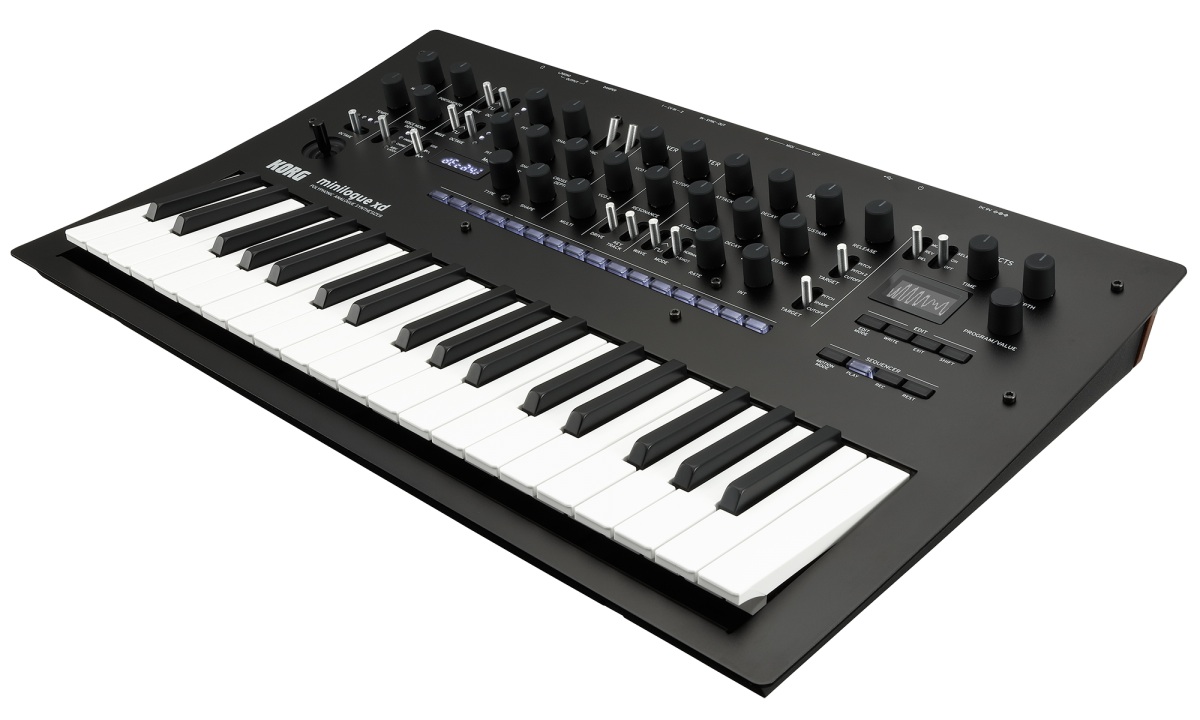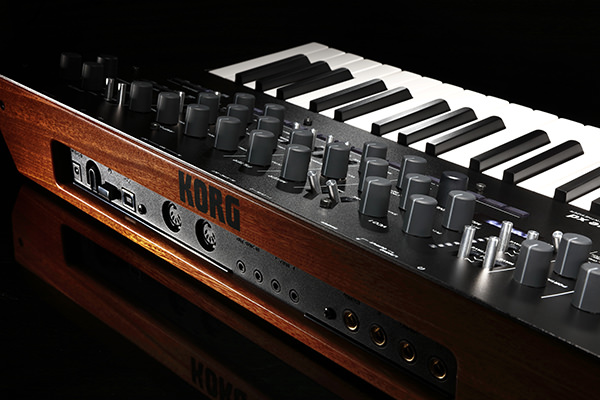New Gear Review: minilogue xd by Korg

Korg furthers the popular minilogue with the new minilogue xd, injecting new digital circuitry into the previously all-analog design.
The success of Korg’s original minilogue synthesizer, released back in 2016, proved two things:
1. That musicians still clamored after accessible analog sounds, and
2. That a newly designed instrument could compete with the characterful vintage synths of the past.
The minilogue has found its way into all sorts of genres and stages; unsurprising given its lightweight and control-laden design. The range expanded in 2017 with the monophonic monologue (which I reviewed shortly after its release) and the larger prologue, which is offered in both eight- and sixteen-voice variants.
But Korg had another trick up their sleeve last year when they announced the minilogue xd, an update to the original analog design that saw a new splash of digital circuitry.
So how does it stand up to the original minilogue, or even the larger prologue?
Features
The minilogue xd is a four-voice analog and digital polyphonic synthesizer with 37 mini keys that are velocity sensitive. It comes with 500 patches, 300 of which are free for user storage. There’s a lot of connectivity for a synth in this price range: stereo outs, sync in and out jacks for compatibility with volcas and the Teenage Engineering PO range, MIDI in and out on full size jacks, a headphone output, a damper input (which is a nice touch), as well as two CV inputs on 3.5mm jacks, which allow the minilogue xd to interact with a wide range of gear.
The xd also features a USB port for MIDI over USB and for using the Librarian from Korg. This allows you to not just back up and transfer patches, but also to transfer custom waveforms for the third oscillator—more on this later.
There are, unsurprisingly, three oscillators. The first two are very similar to the minilogue, which is no bad thing. Both are fully analog and offer saw, triangle, and square shapes with continual wave shaping via the Shape knob. It’s also possible to sync oscillator two to oscillator one, as well as add ring modulation via the flick of a switch. There’s also a dedicated knob for Cross Mod Depth; using these controls in conjunction with the Shape knob offers a lot of timbral possibilities.
The third oscillator is a new multi engine design that comes from the larger prologue model and features three sound sources to choose from. There is a noise generator with four types of white noise, a VPM oscillator (“Variable Phase Modulation”, which is Korg’s take on FM sounds) with sixteen different waveforms, and finally there’s the option to upload your own oscillator programs via single cycle waveforms. This digital engine greatly expands the sound palette of the minilogue xd compared to the original, allowing for all kinds of metallic and harsh sounds to be blended in with the two analog oscillators.
Besides the addition of this new third oscillator, the synth engine architecture hasn’t changed much from the original minilogue: the three oscillators are fed into a mixer via dedicated level knobs, which are then fed into the newly tweaked filter. The filter has switches to turn on both drive and key tracking, but there are only settings available at 0, 50 or 100% intervals. It would have been nice if drive was controlled by a knob, like on the monologue.
There’s a full ADSR envelope for amplitude modulation, as well as a simple attack/decay envelope for controlling the filter, complete with a bipolar EG knob, which is a nice touch. Some users might have wished for a full ADSR envelope for the filter settings as well, but I didn’t find myself missing it too much.
There’s but a single LFO with the normal waveform variants. The LFO has the ability to run in normal or one-shot modes, where it can essentially function as a second envelope. There’s also now the option to sync it to the master BPM, which greatly aids in programming rhythmic sounds. The LFO can modulate pitch, shape, and cutoff in varying amounts.
The end of the signal chain now features a greatly expanded effects section compared to the original minilogue, whose only effect was a single delay setting. The xd now has three categories of effects: reverb, delay, and modulation, each with several different options to choose from. As mentioned, there is also the ability to upload your own effect algorithms; this is something that advanced users will surely want to dive into to further customize their xd’s sonic range.
The minilogue xd also features the same polyphonic sixteen-step step sequencer that initially debuted on the original, but with slightly more usability due to the row of sixteen buttons directly below the front panel controls. The step sequencer works in both real time and step recording modes, and stores a sequence per pattern. It also features the ability to turn steps off and on via the front panel buttons; pressing and holding one of the steps also allows for quick changing of the pitch, which is a great way to add some improvisation to a pattern.
Finally, some users will appreciate the fact that the minilogue xd can load and store microtuning scales and settings, where the pitch of each key is manually adjusted. This is another feature ported over from the monologue, and it adds even more depth to the sonic scope of the xd. There are 23 presets (some from artists like Dorian Concept and Taylor McFerrin), as well as the ability to store six of your own. While it’s unlikely that microtuning will be a big selling point for the majority of users, it does allow the minilogue xd to get to more experimental realms quite easily.
In Use
Scrolling through an instrument’s included presets isn’t always the best way to judge its sonic character, but in the case of the minilogue xd, it’s a very good place to start. This is in large part because Korg have included a lot of presets, of which there are a healthy dose of bread and butter sounds, to more experimental patches that make use of that third digital oscillator. If you’ve played the original minilogue, you’ll know what to expect for the most part, but Korg has also included quite a few patches that would have never been possible on that original design. The greatly expanded effects aid in this to a large degree, and they sound great as well. The reverbs in particular can add a soft hue around the analog oscillators.
Despite the fact that four voices might seem light to many users, the four voice modes of the xd allow a fair amount of flexibility coupled with the Voice Mode Depth knob. In normal Poly mode, the Depth knob actually changes the play mode to Duophonic and adds a variable detune. Unison mode works as you’d expect, with all four voices dedicated to a single note at a time. Chord mode is similar to the original minilogue; the Depth knob changes what kind of chord is triggered. Finally, the Arp/Latch mode offers several arpeggio variations, while flicking the switch down a second time latches notes until released.
Korg has clearly put some thought into the usability of this new synthesizer, as several improvements make it much more playable than the original minilogue. The first is that the often-maligned spring loaded lever on the OG minilogue has been replaced with a very capable joystick that can not only control pitch bend and modulation but can be assigned to control whatever parameter you’d like. While the joystick is a bit small, it greatly aids in how expressive the minilogue xd feels.
The OLED screen of the original has also been enlarged to nearly twice the size, making it much easier to read and to use the built-in oscilloscope, one of the most talked-about features of the minilogue range.
To Be Critical
Just like on the original minilogue, some users might still not like the smaller keys, and they do make faster runs or complex chord shapes a bit tougher. They work fine for playing leads or bass parts however. While the overall ergonomic experience of the minilogue xd was very pleasant, I found the placement of the main volume knob a bit clumsy. I would have preferred it at the top right instead of top left. It’s also quite easy to bump oscillator pitch knobs when adjusting each oscillator’s shape, so some careful tweaking is required. And it’s hard to not pine for a larger cutoff knob similar to the original minilogue!
As mentioned, I also found myself wishing there were more control and subtlety over the drive. More importantly, when engaging the drive, I noticed a slight cut in sound, which limits its usefulness on stage or in recording situations.
Summing it Up
If you already loved the original minilogue, there’s a good chance that feeling will extend to the xd. A bigger OLED screen, the expanded functionality of the step sequencer, the joystick, the expanded effects, and the enhanced CV connectivity make this minilogue experience an even more joyous one. The inclusion of the multi engine really broadens the scope of possible sounds, and though there are fewer voice modes, the minilogue xd still feels incredibly capable.
This synthesizer is lightweight enough to travel with, tactile enough to use on stage, and more importantly, shows that Korg is willing to continue improving upon their designs. At $649 new, the minilogue xd is a bit more expensive than the original minilogue, but it’s likely to fill more duties in your studio given the expanded feature set.
Leo Maymind is a producer, DJ, and writer living in Los Angeles, CA. He is obsessed with sound, and you can reach him at lmaymind@gmail.com.
Please note: When you buy products through links on this page, we may earn an affiliate commission.








[…] The minilogue has found its way into all sorts of Read more… […]